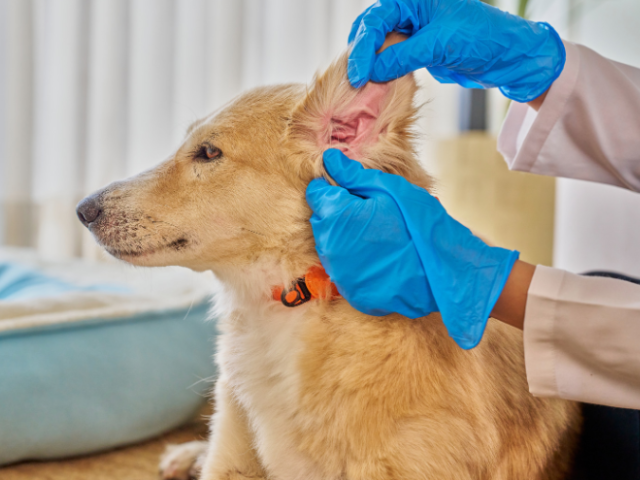A ScriptWorks Event Bringing Veterinary Experts New Knowledge for Enhancing Their Vet Practice
At ScriptWorks, we believe sharing knowledge and the newest innovations in animal medications allows veterinary professionals to provide optimal options for better outcomes.
That’s the idea behind this fall’s Virtual Talk with Matt Brensel & Bob Brensel (ScriptWorks’ Father/Son Pharmacy Experts) on November 10 at 7 PM (PST). Join our live online discussion as we explore practical and innovative compounding approaches for today’s most common veterinary challenges. We’ll discuss how pharmacists and veterinarians collaborate to create patient-specific solutions through a California veterinary compounding pharmacy.
The event will provide a look at real-world challenges — from dosing difficulties in dogs to emerging feline conditions — and highlight the latest tools, techniques, and technologies shaping modern veterinary practice.
Inside Our Virtual Talk: Some of the Topics to Expect
During the session, Bob Brensel, RPh and Matt Brensel, PharmD will share how pharmacists and veterinarians collaborate to create formulations designed around each pet’s unique needs. They’ll discuss how compounding supports medication management, offering insight into ways individualized preparations may make care more practical for pets and their owners.
The talk will include general examples of how medications are prepared in forms that may better suit animal behavior and tolerance — illustrating how thoughtful formulation supports comfort, compliance, and ease of use.
They will also present recent innovations at ScriptWorks that continue to support veterinary professionals, exploring new methods, innovations, and case examples in California veterinary compounding — demonstrating how collaboration improves patient-specific care.
TOPICS:
Canine Predicaments and Compounding Solutions
Dogs are frequent visitors to veterinary clinics, and their medication needs vary widely. The discussion will begin with common canine scenarios where California veterinary compounding supports veterinarians in addressing form, flavor, and dosing.
- Heartworm Management Support — Exploring flexible delivery options when standard medications present challenges.
- Commonly Requested Formulas: Doxycycline and Prednisolone — Examples of medications compounded to support accurate dosing and easier administration.
- Silicone Oil Gel Vehicles for Burns — For protective coverage and application comfort in clinical care.
Dermatitis and Skin Support
Dermatitis remains one of the most common reasons veterinarians may seek customized topical formulations.
- Atopic dermatitis — A challenging disease for both pets and owners. Its chronic nature requires patience and lifelong care. Personalized planning supports ongoing comfort and helps make management more consistent.
- Bacterial dermatitis — Often triggered by single or multiple causes. Resistant bacteria may complicate care, and adjusted formulations may help veterinarians develop plans suited to each case.
- Fungal dermatitis — Caused by fungal infection, it may spread within the household. Customized formulations may help veterinarians in designing approaches that fit each pet’s environment and routine.
- Flea-related dermatitis — Causes total discomfort until the source is resolved. Individual care strategies may help veterinarians guide owners toward plans that consider both the pet and the home setting.
GI Issues and Digestive Support
Cats and dogs aren’t always cooperative when it comes to medication, especially when nausea or diarrhea is part of the problem. This part of the discussion explores how compounding makes these prescriptions potentially more manageable for both pets and owners.
- Nausea — Adjusted strengths and veterinarian-directed preparations may help maintain consistent dosing for sensitive animals.
- Diarrhea — Custom formulations give veterinarians flexibility to modify ingredients that support comfort and tolerance.
Wound Care and Pain Support
Injuries and post-surgical recovery often require ongoing attention. Compounding provides veterinarians with options to match medication forms with each animal’s specific needs.
- Pregabalin — Some cats become distressed during transportation or veterinary visits, where anxiety makes handling difficult. Veterinarians may include pregabalin in care plans to support calmer experiences during these situations.
- Gel Bandage Systems — Helps maintain a protective and comfortable environment for wounds, supporting ease of care for both pets and owners.

Otitis and Pseudomonas Considerations
Ear conditions are common in veterinary practice and may require customized management. Compounding medications, such as ScriptWorks Bi-Phasic Gel, provides veterinarians with the flexibility to tailor care plans suited to the ear’s delicate environment.
- Otitis — Inflammation of the ear canal may result from allergies, moisture, or infection. Veterinarian-guided formulations allow ingredient adjustments for comfort and precision.
- Pseudomonas — This bacterium can complicate ear conditions. Under veterinary supervision, preparations are adjusted in strength and form to match each case.
Dental Care and Oral Health
Oral care supports long-term wellness but is often overlooked in pets. Compounding offers accommodation in designing medications suited to each animal’s tolerance and behavior.
- Canine Periodontal Disease — Ongoing management often includes home care and follow-up. Adjusted strengths and flavors may make routines easier.
- Gingivitis — Personalized formulations may help owners stay consistent with daily care.
Low Dose Naltrexone in Veterinary Medicine
Low-dose naltrexone is an area of growing interest in veterinary medicine. The discussion will focus on formulation precision and communication between prescribers and pharmacists.
“Low-dose-naltrexone (LDN) pharmacotherapeutically possesses immunomodulatory, anticarcinogenic, antiviral, antibacterial, antiparasitic, and antifungal properties.”
A Case Study Involving LDN
Miley, a 12-year-old English Sheepdog, suffered from chronic hind limb pain, stiffness, and loss of mobility. Working closely with her veterinarian, a compounded LDN preparation at 4 mg once daily was introduced as part of her care plan.
Her caregiver later described increased mobility, alertness, and social engagement over time. Her carer also detailed that Miley lived for another two years with reduced discomfort.
Canine Degenerative Myelopathy
Canine degenerative myelopathy is a progressive condition that affects the spinal cord in older dogs, leading to weakness and loss of coordination. For long-term cases, compounding allows veterinarians to adjust dosage forms or strengths to potentially improve ongoing support and comfort.
Feline Hypereosinophilic Syndrome
Feline hypereosinophilic syndrome occurs when an excessive number of eosinophils — a type of white blood cell — spreads throughout various organs. This buildup affects various parts of the body and leads to a wide range of issues. Because every case differs, veterinarians may work with compounding pharmacists to prepare medications that align with each cat’s needs and sensitivities.
“Both cats were diagnosed with hypereosinophilic syndrome by the findings of increased eosinophils and their precursors in the bone marrow, eosinophilic infiltration into multiple organs, and exclusion of other causes for eosinophilia.”
Feline Infectious Peritonitis
Feline Infectious Peritonitis is a serious viral disease in cats caused by a mutation in a feline coronavirus. The infection may trigger an abnormal immune response that affects organs and blood vessels. Veterinarians may collaborate with compounding pharmacies to prepare formulations that match supportive care.
What’s New at ScriptWorks: Advancing California Veterinary Compounding
As part of our Virtual Talk, Matt will share insights into clinical veterinary pharmacy, discussing exciting happenings, from recent recognitions to the growing role of AI in veterinary compounding in California. ScriptWorks Pharmacy continues to explore ways to make its services more precise, efficient, and responsive to the needs of veterinarians and their patients.
Join the Conversation
REGISTER: Monday, November 10, at 7 PM PST (via Zoom)
Topic: What’s New in Veterinary Compounding & Collaboration with Your Local Clinical Pharmacist
For inquiries, contact info@ccvma.org or refer to the Fall Newsletter for more information.
Supporting Veterinary Care Across the Bay Area and Beyond
ScriptWorks proudly serves veterinarians, clinics, and pet owners throughout the Bay Area and across California, offering dependable support for individualized veterinary care. With more than 20 years of experience in veterinary compounding, we combine trusted expertise with a commitment to safety and precision in every preparation.
Each prescription is created with the animal’s unique needs in mind — formulations designed to match the veterinarian’s direction and the patient’s comfort. With next-day shipping available statewide, we make it easier for veterinary teams and pet owners to access the medications they need without delay.
References
- Gedon, N. K. Y., & Mueller, R. S. (2018). Atopic dermatitis in cats and dogs: A difficult disease for animals and owners. Clinical and Translational Allergy, 8(1), 41. Link
- Loeffler, A., & Lloyd, D. H. (2018). What has changed in canine pyoderma? A narrative review. The Veterinary Journal, 235, 73–82. Link
- Dworecka-Kaszak, B., Biegańska, M. J., & Dąbrowska, I. (2020). Occurrence of various pathogenic and opportunistic fungi in skin diseases of domestic animals: A retrospective study. BMC Veterinary Research, 16(1), 248. Link
- Carlotti, D., & Jacobs, E. (2000). Therapy, control and prevention of flea allergy dermatitis in dogs and cats. Veterinary Dermatology, 11(4), 285–296. Link
- Lamminen, T., Korpivaara, M., Aspegrén, J., Palestrini, C., & Overall, K. L. (2023). Pregabalin alleviates anxiety and fear in cats during transportation and veterinary visits—A clinical field study. Animals, 13(3), 371. Link
- Marangaloo, R. G., Pinar, O., Mehmedov, T., & Or, M. E. (2024). Current pharmacotherapeutic properties of low-dose naltrexone therapy in humans and possible therapeutic and prophylactic indications in cats and dogs. German Journal of Veterinary Research, 4(1), 39-45. Link
- Takeuchi, Y., Matsuura, S., Fujino, Y., Nakajima, M., Takahashi, M., Nakashima, K., Sakai, Y., Uetsuka, K., Ohno, K., & Tsujimoto, H. (2008). Hypereosinophilic syndrome in two cats. Journal of Veterinary Medical Science, 70(10), 1085-1089. Link
Missed our Virtual Vet Talk?
We’ve got you. You can still access the virtual event recording and catch every detail you missed. Just use the form below, and we’ll send the full session straight to your inbox.


